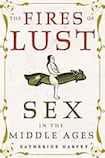
If you’ve ever said “that’s so medieval”, you should read this book. Katherine Harvey begins by ruthlessly demolishing stereotypes held by everyone except medieval historians. For example, the infamous droit du seigneur is a myth: there is no evidence that medieval lords were entitled to take the virginity of a bride on her wedding night.
Unsurprisingly, religious teachings on sex feature prominently throughout. The moral strictures of Christianity dominated medieval life, ordering intimate relations between men and women as well as in same-sex encounters. Virginity was prized above all other states because every virgin got into heaven. Yet virginity was not purely physical – it was also spiritual, and these two states were not mutually dependent. Hence 15th-century mystic Margery Kempe, a married mother of 14, could be “a maiden in [her] soul”.
It’s fair to say that medieval people were extremely preoccupied with virginity. In the numerous court cases cited by Harvey, the virgin status of women was always noted. Virginity was a physical condition that could be verified by examination – rape survivors were examined by midwives, women experienced in gynaecological matters. Assaulting a virgin was considered more grievous than assaulting a woman of dubious virtue. Unfortunately for women claiming rape, their bodies were not always easy to interpret. For medieval people, virginity was simultaneously a physical truth and a speculative condition.
Harvey delights in pointing out the contradictions between rigid sexual standards and the messy lives of human beings, using court records to great effect. The named men and women arguing in court over what happened between them provides gripping drama. I was enthralled by the walk-on parts of otherwise invisible historic people, parading their bodies and behaviours in front of clerics and priests. Their dilemmas bring a culture that placed great weight on sexual behaviour to life.
There are many distressingly memorable examples of sexual violence, as accuser and accused faced each other in adversarial trials
Regardless of its moral power, the virgin state was not especially popular. Most people did not wish to die a virgin, meaning sexual “continence” – sexual discipline – was extremely important. Through chapters on marital sex, immoral behaviours, sexual positions and violence, Harvey reveals how medieval people regulated expressions of lust.
Morally appropriate sex was narrowly defined. It was confined to marriage and one single position: missionary with the man on top. Anything else could be considered “bestial”. Secular and religious authorities were deeply worried by the moral and social damage caused by sex in the wrong place, with the wrong person and in the wrong way.
A strength of the book is in how Harvey questions the effectiveness of such religious and legal prohibitions. Rules and regulations were promulgated by powerful literate men but she warns us against assuming their laws were accepted by the masses. Plentiful examples of sexual wrongdoing prove that medieval people struggled to curb their desires. People committed sacrilegious sex in churches. When Jeanne Saignant, in 15th-century Dijon, had sex standing up, it proved she was perverted. That her neighbours complained of this behaviour gives an insight into how sex acts were not confined to private bedrooms.
Given the moral and social norms, it was easy to have the wrong kind of sex. Indeed, a person’s health could be damaged by too much or too little fornication. Unbridled, wanton lust could overrule and destabilise medieval society if not carefully regulated.
The thorny question of coercion and consent runs through many of the sexual encounters described in this book. I couldn’t help but shudder at the epidemic of rapes in Dijon between 1436 and 1486, when at least 125 rapes were reported. These were brutal attacks on women from poor backgrounds. Harvey explains that the perpetrators were not punished and that the assaults were a way for young unmarried men to challenge authority.
The fear felt by women wasn’t confined to the lower classes: women from powerful families were verbally threatened in the streets. There are many distressingly memorable examples of sexual violence in the pages of this book, as accuser and accused faced each other in adversarial trials. The inequitable punishments imposed by authorities show that capricious justice systems are nothing new.
While few men alleged sexually assault by women, medieval men were nonetheless afraid of women. They feared women would control male bodies not with violence but with magic. A devious woman who made bread with blood, and then kneaded it on her buttocks, would inflame her husband’s love.
This lively, engaging study combines a scholarly rigour with a sharp eye for telling detail, told in a fluid style that keeps the pages turning. A culture in which clerics commissioned sheelagh-na-gigs – graphic carvings of women displaying their genitals – to adorn their holy buildings can perplex us. Harvey takes great care to explain this complicated culture. It’s a bonus that the book’s funniest moments are too explicit to be quoted in a daily newspaper.
Dr Aoife Bhreatnach hosts Censored, a podcast about banned books










